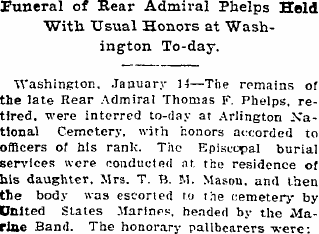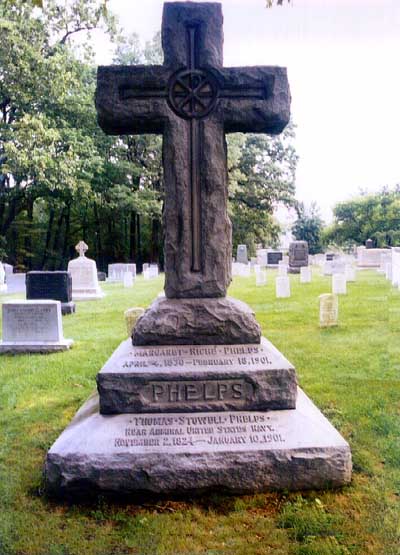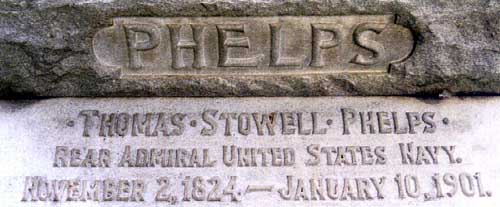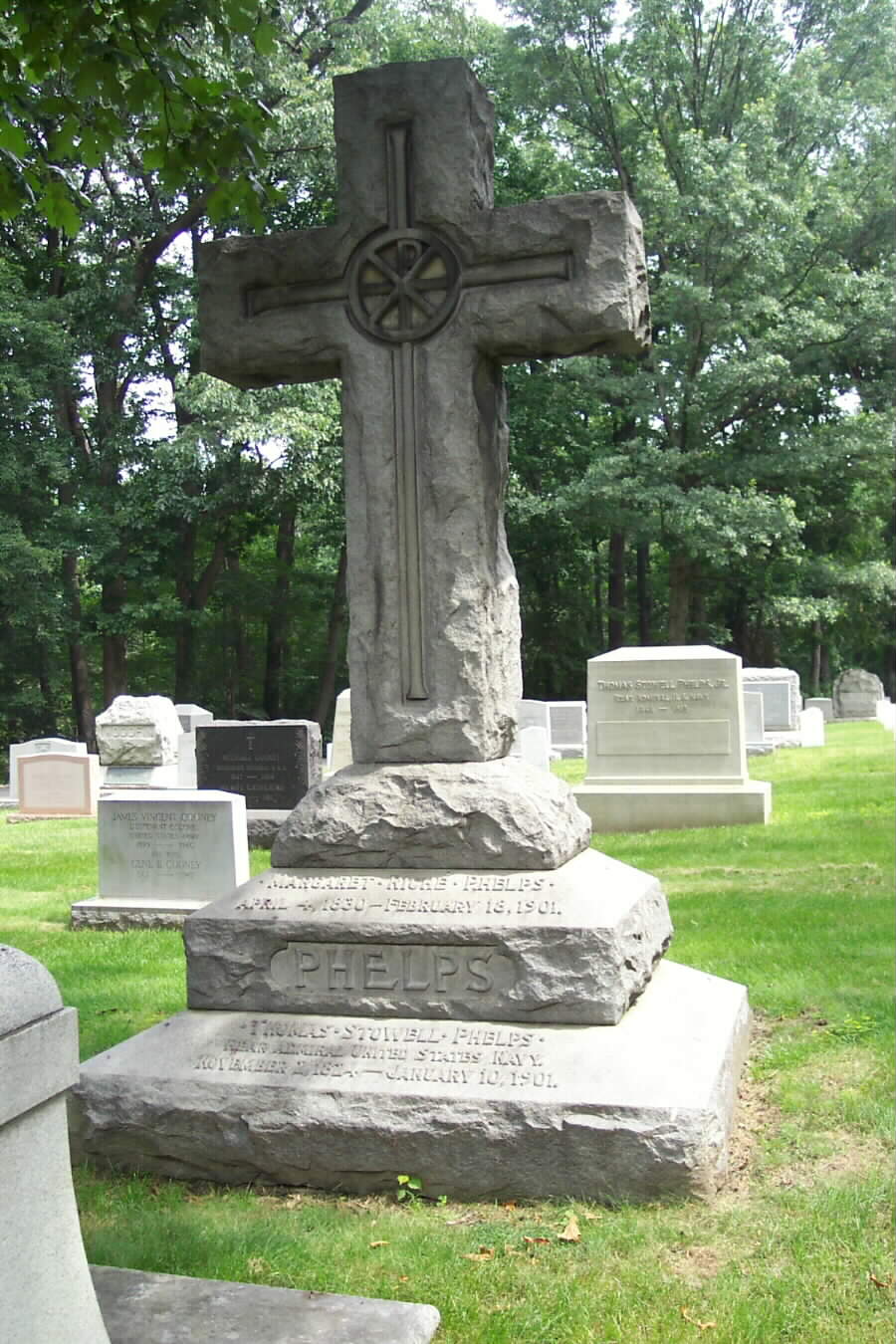Thomas Stowell Phelps was born in Buckfield, Maine, 2 November 1822. He served in the Navy from 1840 to 1884, attaining the rank of Captain in 1871 and Rear Admiral in 1884. He served in the Mediterranean, the Atlantic and the Pacific and commanded the USS Juniata during the capture of Fort Fisher in January 1865. He died in New York City in 1901, and was buried in Arlington national Cemetery (Section 1 grave 504).
Born at Buckfield, Maine, on 2 November 1822. He married Margaret Riche Levy. He had at least one son, Rear Admiral Thomas Stowell Phelps, Jr., United States Navy (1848-1915). He died in the Naval Hospital in New York City on 10 January 1901.
He received appointment from Maine, 17 January 1840 He served on the Labrador Coast then with the Mediterranean Squadron, March 1840-Septemebr 1843, on leave, September-October 1843; on the USS Boston, Brazilian Squadron, October 1843-February 1846; at the Naval School, Annapolis, Maryland, February-July 1846; USS Boston, Gulf Squadron, October 1846-Februruary 1847; USS Polk, Home Squadron, February-May 1847; USS Independence, Mediterranean Squadron, June 1849-December 1850; USS Constitution, Mediterranean Squadron, December 1850-February 1851; Coast Survey Duty, May 1851-August 1852; USS Pennsylvania, Norfolk, Virginia, August 1852-January 1853; USS Fulton, Home Squadron, January-February 1853; Survey Duty on the Elizabeth River, Virginia, then at the Navy Yard, Norfolk Virginia, December 1853; USS Decatur, Pacific Squadron, December 1853-March 1857; Ordnance Duty, Navy Yard, Norfolk, Virginia, May 1857-September 1858; USS Western Port, Brazilian Squadron, and Paraguay Expedition, October 1858-June 1859; USS Crusader, Home Squadron, June-August 1859; Commander, USS Vixen, Coast Survey Duty, August 1859-September 1861; USS Corwin, special secret service, September 1861-January 1862; North Atlantic Blockading Squadron, March-June 1862; special duty, Potomac River, June 1862-March 1863; Special Survey duties, March 1863-December 1864; Commander, USS Saugus, South Atlantic Blockading Squadron, December 1864-January 1865; Commander, USS Juniata, South Atlantic Blockading Squadron, January-February 1865; Commander, USS Lenapee, Atlantic Coast Squadron, March 1865-April 1867; Navy Yard, Mare Island, California, November 1867-November 1870; Commander, receiving ship USS Independence, Mare Island, November 1870-September 1871; Commander, USS Saranac, North Pacific Squadron, September 1871-October 1873; temporary duty, October-November 1873; without orders, November 1873-March 1874; Executive Officer, Navy Yard, Mare Island, March 1874-April 1877; without orders, April-September 1877; commander, USS Independence, Mare Island, September 1877-February 1879; without orders, February-December 1879; Commander, Navy Yard, Mare Island, January 1880-March 1883; Commander, South Atlantic Squadron, USS Brooklyn, June 1883-October 1884; without orders, October-November 1884; pleased on the retirement list, 2 November 1884.
He served in the Indian War in Washington Territory and at the Battle of Seattle on 26 January 1856. Owing to his coast survey experience, he was chosen at the outset of the Civil War to survey and chart the Potomac River after many navigational aids had been destroyed or made inoperative by Confederate forces. Similarly engaged in secret survey work in Virginia waters, his efforts were noted by the Secretary of the Navy.
Thomas Stowell Phelps, Naval Officer, born in Buckfield, Maine, 2 November, 1822.
He was graduated at the United States naval academy in 1846, became Lieutenant in 1855, served in the Indian war in Washington territory in that year and in 1856, and in the Paraguay expedition in 1858-‘9.
At the beginning of the Civil War he was attached to the expedition that was sent to the relief of Fort Sumter, and in June, 1861, was selected to co-operate with the army and navy in preparing a survey of Potomac river. He was transferred in September to the steamer ” Corwin” for secret service, examined five of the inlets of North Carolina, surveyed and buoyed Hatteras inlet for the introduction of expeditions into the interior waters of that state, skirmished with Confederate gun-boats in Pamlico sound, and engaged the gun-boat “Curlew” in Hatteras inlet on 14 November. He was in three engagements with Yorktown and Gloucester point batteries, caused the destruction of two of the enemy’s vessels, and thwarted that of White House Bridge in April and May, i862. At the battle of West Point he prevented the conjunction of a large force of Confederates with the main army. He became Lieutenant Commander in July, 1862, was subsequently engaged chiefly in surveying and examining dangers in the way of blockades and transports, and commanded the “Juniata ” in the Fort Fisher fights in 1865.
He was commissioned Commander in that year, captain in 1871, Commodore in 1879, and rear-admiral in 1884, and retired in 1885. He has published “Reminiscences of Washington Territory” (New York, 1882).
PHELPS, THOMAS STOWELL
RADM USN
- DATE OF DEATH: 01/10/1901
- BURIED AT: SITE 504
ARLINGTON NATIONAL CEMETERY
PHELPS, MARGARET R W/O T S
- DATE OF DEATH: 02/18/1901
- BURIED AT: SECTION EAST SITE 504
ARLINGTON NATIONAL CEMETERY
PHELPS, THOMAS S JR
RADM USN
- DATE OF DEATH: 11/03/1915
- BURIED AT: SECTION WS SITE 506
ARLINGTON NATIONAL CEMETERY
Michael Robert Patterson was born in Arlington and is the son of a former officer of the US Army. So it was no wonder that sooner or later his interests drew him to American history and especially to American military history. Many of his articles can be found on renowned portals like the New York Times, Washingtonpost or Wikipedia.
Reviewed by: Michael Howard




